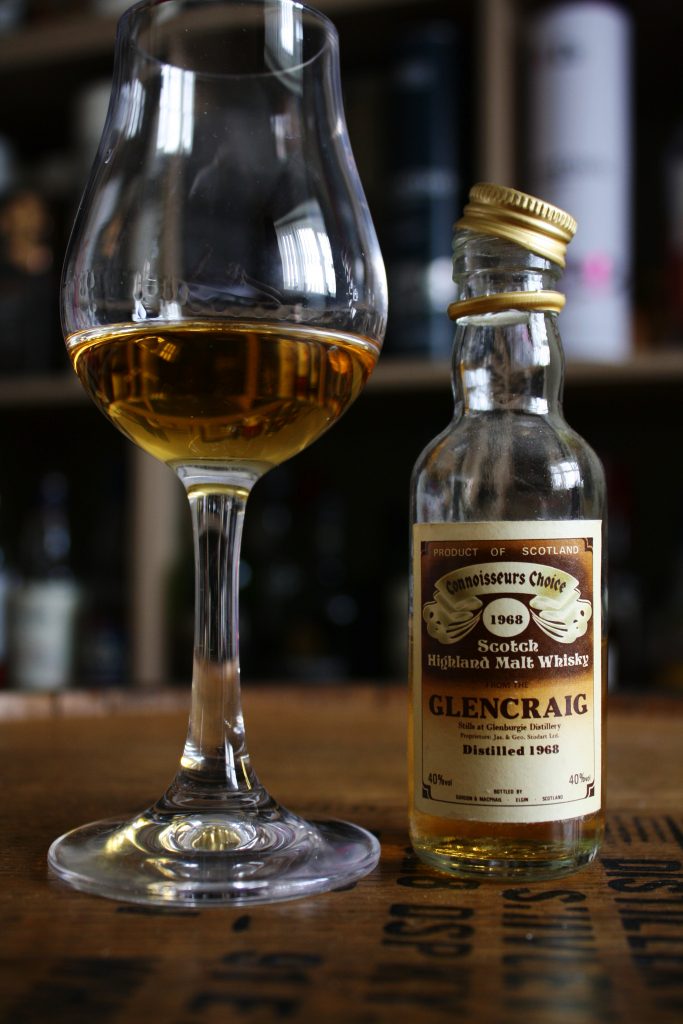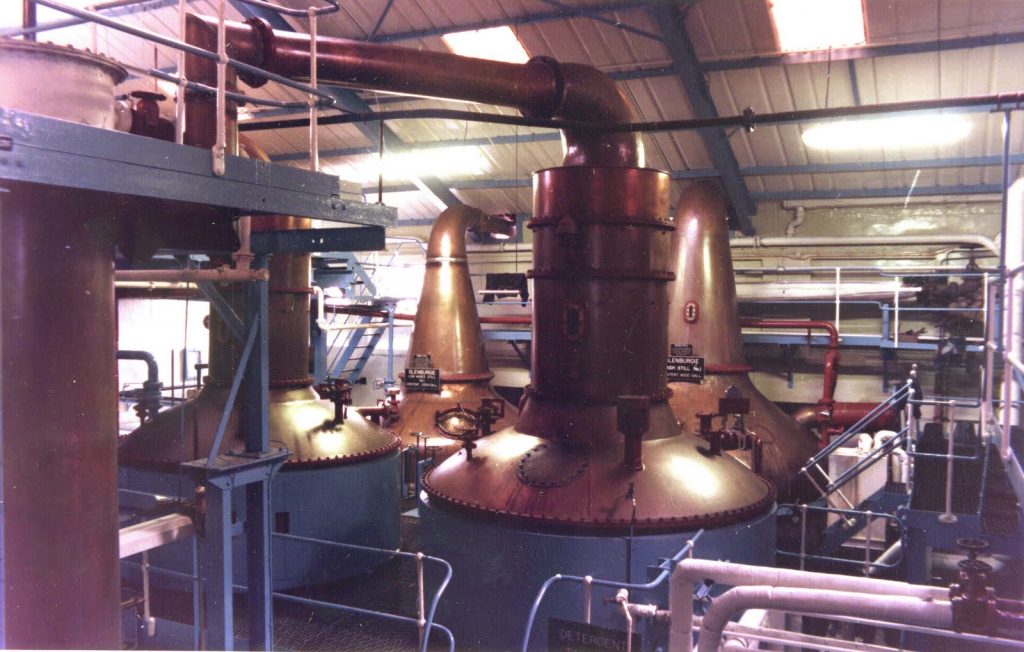Glencraig 1968 Gordon and Macphail

When you hear the words Lomond stills, the first thing that may come to mind would be the Loch Lomond distillery. They do indeed have straight neck pot stills that look similar to Lomond stills, which have been at the distillery since it was constructed in 1965, with more added recently. These however are not Lomond stills, although many websites I have stumbled across during my research call them such. From what I can discover, they have a head cooling system, a greater number of plates on the spirit still and fewer on the wash still, and they have a much taller column than you would see on a Lomond still.
The Lomond still is kind of a hybrid of a traditional pot still and a column still, with a bulbous shaped bottom and a straight neck, which contained three rectifying plates that could be removed or adjusted depending on the style of spirit required. The plates were cooled by flooding them with distillate, which would cool the spirit as it was rising. The more plates you flooded, the greater the reflux of spirit back into the pot for re-distillation, ensuring only the lighter components got through. The stillman could decide which ones to flood with distillate (if any) and even remove plates if they wished for a heavier style. This ability to adjust the plates was intended to mimic the longer or shorter swan necks of a traditional pot still, so in theory many different types of spirit could be produced. The positioning angle of the lyne arms could also be altered.
The still was developed by Alastair Cunningham and Arthur Warren from Hiram Walker in 1955. The first one was installed at the company’s Dumbarton facility, which produced Dumbarton grain whisky and Interleven malt. By combining a Lomond spirit still with an Interleven wash still, they produced a whisky known simply as Lomond – presumably because the distillery was located not far from the loch. It’s a whisky which is almost impossible to find now, with production taking place between 1956 and 1985. The still from Interleven is now used by Bruichladdich to make Botanist gin.
Another distillery to have Lomond stills installed was Miltonduff. You may well have seen a number of independent bottlings of this under the name Mosstowie. They were one of only two distilleries under the Hiram Walker umbrella to use a pair of Lomond stills together, rather than combined with a traditional pot still. More on the other shortly.
Scapa on Orkney currently uses a Lomond still as a wash still at its distillery, but they no longer use any rectifying plates. Despite this, the amount of copper in the neck of the still is large, and combined with a purifier pipe the reflux is quite high. The Lomond still was installed in 1959 and was used as intended up until 1979, before the plates were removed.
Hiram Walker’s original intention was for the stills to produce spirit for the company’s Ballantine’s blends, so if you find any 60’s or 70’s examples at auction, they are likely to have whisky produced from these unique stills in them. Eventually, the stills became out of favour due to the plates needing regularly cleaning to remove the solid particulates from the spirit that accumulated in them over time, and slowed down the process. There was also a lack of interest from blenders, who preferred the malts produced from the regular pot stills.
Interestingly, Inchdairnie have brought back the Lomond still, and have the only one in the industry currently being used with rectifying plates, alongside a pair of traditional copper pot stills. The plan is to use them for triple distillation. There have been a few independent releases from the distillery, but we will have to wait until 2029 for the core range to go on sale. A look at their website seems to suggest the Lomond still is being used to create single grains, with rye and oats being used. The SWA threw up a bit of a stink about Lomond stills in their 2009 regulations, which perhaps could be part of the reason.
Then we come to Glencraig, which is the name given to the whisky produced using a pair of Lomond stills at Glenburgie distillery between 1958 and 1981, the other distillery along with Mosstowie where you can try 100% Lomond still distilled single malt. You still see this floating around at auction, with full size bottles reaching well into the hundreds of pounds to buy, and recently released independent bottlings into four figures with retailers. I picked this one up for £20 about a year ago.

This Glencraig was distilled in 1968, and although the bottle makes no mention of when it was bottled, the research I have done suggests it was bottled by Gordon and Macphail at 16 years old in 1984. As with many of these older whiskies from G&M, it was bottled at the basement abv of 40%. However, without companies such as them, many of these whiskies would be lost to the history books, and I wouldn’t be able to try this today.
Glencraig 1968 Gordon and Macphail Connoisseur’s Choice – Review
Nose : Its a little waxy, with both sweet, fresh lemon and lemon scented polishes. Its all lemons on the fruit front, but that’s fine when they are this good. There’s barley sugar, honey, olive oil and fresh cut flowers, along with white linen fresh off the washing line. At 40% I was hesitant to add water, but a couple of small drops brought out more of those floral notes. A rather elegant nose and an excellent start.
Palate : It’s all lemons and waxes again, rather sour lemons and some orange peel. The first few moments are promising, but oh no, bitter wood notes appear, and they aren’t subtle or balanced, and continue through the development. Once they subside a touch we get the lemon back, along with honey, peppery spice and creamy vanilla, but that woody bitterness has unfortunately gone a little too far, and ultimately produced a whisky that couldn’t live up to the promise from the nose. The finish is drying , with the remains of the bitter wood, cask char, lemon and cream.
Conclusions : I have read a couple of reviews of this very whisky – after I wrote my notes…honest guv! There is one from Serge Valentin on Whiskyfun and one from the Malt Maniacs website which was apparently sampled on an Islay beach – lovely, but perhaps not the right environment for analytical dramming. Neither were particularly favourable, with scores of 76/100 from Serge and 50/100 from the mystery Malt Maniac. Serge’s thoughts backed up the woody bitterness on the palate, which spoils an otherwise promising whisky. With these old bottles its nice to have another perspective, as some will survive their years in the glass better than others. The nose is delightful, and for that alone it deserves a score which isn’t too harsh, and the bitterness on the palate isn’t a complete car crash and does relent after a short while.
I am going to be featuring more from my miniature collection in my next review, so i’m expecting the readership to drop somewhat from my usual reviews of widely available bottles. I hope at least one or two of you find interest. Writing is an unpaid hobby of mine, so I have to write about what interests me and hope to find a few like minded folks out there.
Although it appears this is not the best example of what Glencraig had to offer, i’ve had a great couple of evenings trying this piece of whisky history, and that is what matters most on the whisky journey. I know…I must be great fun at parties 🙂
Score : 5/10 Average
(Score descriptions can be found in the About page)
Vital statistics
ABV : 40%
Non-chill filtered : No
Natural Colour : If there is caramel, it is very little
Maturation : No information, but from tasting I would say refill ex-bourbon, and I have read it is 16 years old
Region : Speyside
Colour : Gold
